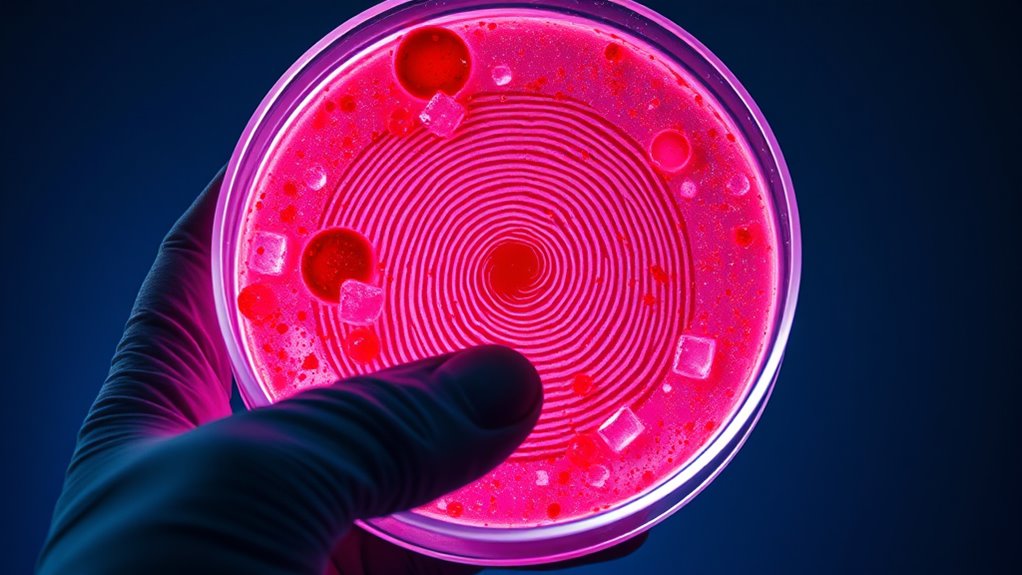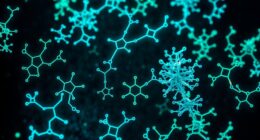By analyzing the unique chemical molecules in your blood, scientists can create a diagnostic “fingerprint” that reveals early signs of disease. Biomarkers like proteins, nucleic acids, and metabolites change as conditions develop, and advanced technologies like mass spectrometry and machine learning help identify these subtle patterns. This approach enables less invasive, faster detection, potentially catching illnesses before symptoms appear. If you want to understand how this innovation is transforming healthcare, there’s more to explore.
Key Takeaways
- Blood contains unique molecular signatures (biomarkers) that reflect the body’s health status and can indicate early disease presence.
- Advanced technologies like mass spectrometry and high-throughput sequencing detect subtle chemical changes in blood samples.
- Machine learning analyzes blood biomarker patterns to identify early signs of diseases such as cancer or Alzheimer’s.
- Blood-based diagnostics enable less invasive, faster, and more accurate early detection compared to traditional methods.
- Continuous research enhances understanding of blood’s chemical fingerprint, paving the way for personalized and proactive healthcare.

Have you ever wondered how doctors can detect diseases long before symptoms appear? The secret lies in turning blood into a diagnostic “chemical fingerprint” that reveals the earliest signs of illness. Recent advancements in biomarker discovery have revolutionized this process, enabling medical professionals to identify specific molecules in blood that indicate the presence of disease long before traditional symptoms emerge. These biomarkers are like unique signatures, reflecting changes in the body’s biology that occur during the initial stages of conditions such as cancer, Alzheimer’s, or cardiovascular disease.
Detect diseases early by analyzing blood’s chemical fingerprint through innovative biomarker discovery.
By analyzing these subtle chemical clues, healthcare providers can make early diagnoses and start treatment sooner, often improving outcomes remarkably. The key to this breakthrough is ongoing diagnostic advancements that leverage cutting-edge technologies such as high-throughput sequencing, mass spectrometry, and machine learning. These tools allow scientists to sift through vast amounts of blood data to pinpoint tiny molecules—proteins, nucleic acids, metabolites—that act as reliable indicators of disease. Additionally, understanding the benefits of early detection**** can motivate continued investment in biomarker research and technology development.
The process of biomarker discovery is meticulous; it involves comparing blood samples from healthy individuals with those from patients at various disease stages. Patterns emerge, revealing which molecules consistently change in response to specific health issues. Once identified, these biomarkers become the foundation for new blood tests that are faster, more accurate, and less invasive than traditional diagnostic methods. The development of advanced analytical techniques has been crucial in increasing the sensitivity and specificity of these tests.
This progress in diagnostic tools opens a new chapter in medicine. Instead of waiting for symptoms to surface or relying solely on imaging and biopsies, doctors can now monitor a patient’s blood for early warning signs. This proactive approach means diseases can be caught at a stage when they’re most treatable, often before irreversible damage occurs.
The ability to decode blood’s chemical fingerprint also provides insights into disease progression and treatment effectiveness, enabling personalized medicine tailored to each individual’s unique biological profile.
In essence, turning blood into a diagnostic “chemical fingerprint” isn’t just about detecting illness; it’s about transforming healthcare into a more precise, predictive science. Biomarker discovery fuels this shift, pushing the boundaries of what’s possible in early detection.
As diagnostic advancements continue, you’ll see a future where a simple blood test can reveal a wealth of information about your health—often before you notice any symptoms—giving you a head start in managing your well-being. This evolution promises a new era in medicine, where early detection saves lives and improves the quality of care for everyone.
Frequently Asked Questions
How Accurate Are Blood Chemical Fingerprints Compared to Traditional Tests?
You might wonder how accurate blood chemical fingerprints are compared to traditional tests. They can offer high biomarker specificity, meaning they target specific disease markers effectively.
However, there’s a risk of false positives, which can lead to unnecessary concern or procedures. While promising for early detection, it’s important to remember that these new methods should complement, not replace, traditional tests until their reliability is fully established.
Can This Method Detect Multiple Diseases Simultaneously?
Think of this method like a multi-tool, capable of detecting multiple diseases at once. Yes, it can enable multimodal detection, allowing you to identify various illnesses simultaneously.
This accelerates early intervention, potentially saving lives by catching diseases sooner. Instead of waiting for separate tests, this approach streamlines diagnosis, giving you an all-encompassing picture of your health quickly and efficiently.
It’s a promising step toward more proactive healthcare.
What Are the Limitations of Using Blood as a Diagnostic Fingerprint?
You should consider that using blood as a diagnostic fingerprint has limitations. Sample variability can affect consistency, making it hard to interpret results accurately.
Additionally, contamination risks pose challenges, potentially leading to false positives or negatives. These issues can impact the reliability of blood-based diagnostics, so you need to carefully control sample collection and processing procedures to guarantee accurate disease detection and avoid misleading results.
How Quickly Can Results Be Obtained Using This Technique?
When it comes to getting results quickly, you’re in the driver’s seat. This technique offers rapid processing and real-time analysis, meaning you can often see results within minutes to a few hours.
It’s a game-changer for early diagnosis, as you don’t have to wait days or weeks. The faster turnaround helps with timely decision-making, making it a promising tool for swift medical responses and better patient outcomes.
Is This Technology Applicable to All Age Groups?
You might wonder about age applicability for this technology. It’s designed to work across all age groups, including pediatric screening.
The method’s sensitivity allows for early detection in children and adults alike, making it versatile for various healthcare settings. Since it’s non-invasive and quick, you can rely on it for early diagnosis regardless of age, helping catch diseases sooner and improve treatment outcomes for everyone.
Conclusion
Your blood becomes more than just a fluid; it transforms into a symbolic map, revealing hidden stories of your health. By deciphering its chemical fingerprint, you hold the key to early diagnosis, turning a simple drop into a beacon of hope. This tiny vessel symbolizes your body’s silent dialogue, waiting for you to listen. Embrace this new era, where blood isn’t just life—it’s a powerful symbol of proactive care and future healing.









